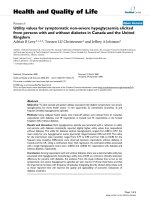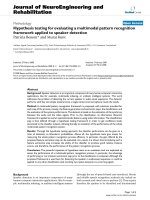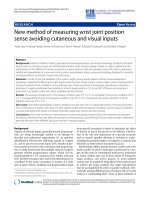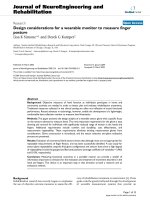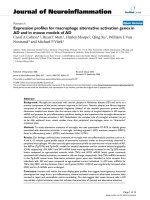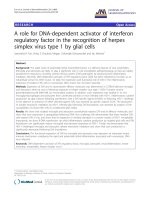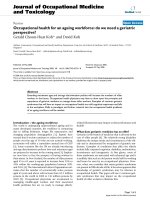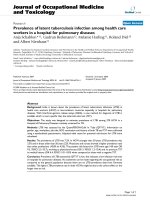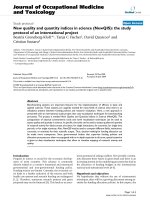báo cáo hóa học:" New diagnostics for tuberculosis: fulfilling patient needs first" pdf
Bạn đang xem bản rút gọn của tài liệu. Xem và tải ngay bản đầy đủ của tài liệu tại đây (270.23 KB, 7 trang )
DEBATE Open Access
New diagnostics for tuberculosis:
fulfilling patient needs first
Jean-François Lemaire, Martina Casenghi
*
Abstract
Background: An effective tuberculosis (TB) control programme requires early diagnosis and immediate initiation of
treatment. Any delays in diagnosing TB not only impair a patient’s prognosis, but also increase the risks of
transmitting the disease within the community. Unfortunately, the most recent TB diagnostic tools still depend on
high-infrastructure laboratories, making them poorly adapted for use in resource-limited settings. Additionally,
existing tests show poor performance in diagnosing TB in children, people living with HIV/AIDS, and
extrapulmonary forms of the disease. As a consequence, TB patients are still to date left with either fair access to
poor diagnostics or poor access to fair diagnostics.
Discussion: This article discusses recent efforts to identify the minimal test specifications for a new TB point-of-
care diagnostic test through an approach bas ed on medical and patient needs. As a first step, survey interviews
with field practitioners were designed in order to identify the top-priority medical needs in resource-limited
settings concerning new TB diagnostics. Subsequently, an expert me eting convening field practitioners, laboratory
experts, diagnostic test developers and researchers was held with the objective of defining the minimal test
specifications for a new TB point-of-care test that would meet the identified medical needs. Finally, gaps in, as well
as potential solutions for, enabling the development of adequate, patient needs-driven, low-cost new TB diagnostic
tests specifically designed for vulnerable populations are discussed.
Summary: Any new TB point-of-care diagnostic test should be designed to meet minimal specifications satisfying
the most urgent medical needs in resource-poor settings. The major gaps for developing a new TB point-of-care
test include identification of new biomarkers, simplification of technological platforms, development of adequate
and accessible specimen banks, and identification and definition of reference standards for diagnosis of childhood
TB. Innovative research and development funding ensuring de-linkage of research and development costs from the
price of the new product, such as a prize fund mechanism, could help focus these efforts towards the delivery of a
much-needed point-of-care diagnostic test for TB.
Background
Tuberculo sis (TB) is a major public health problem asso-
ciated with more than 9.4 million incident cases and
almost 1.8 million deaths in 2008 alone: this is the equiva-
lent of 5000 people dying every day [1]. TB remains the
world’s largest treatable infectious cause of death, with
90% of patients living in resource-limited settings [2], and
the African continent having 14 of the 15 highest-burden
countries in the world [1]. More importantly, an estimated
60% of patients seeking care are found at health-post level
or peripheral health clinics, where adequate laboratory
infrastructure to perform TB l aboratory investigations
often do not exist, not even through sputum smear micro-
scopy (SSM) [3]. Thus, the need to adapt the diagnostic
tools to the burden and reality of the epidemic is crucial.
Although the ideal characteristics for the design of a
diagnostic test for resource-limited settings have been sug-
gested as A ffordable, Sensitive, Specific, User-friendly,
Rapid, Equipment-free, and Delivered (the ASSURED sys-
tem) to those in need [ 3], all exi sting methods and those
under development do not fulfil many of these criteria.
Because of its low cost, long history and basic laboratory
infrastructure needs, SSM remains the most widely used
TB diagnostic test . However, the low sensitivity of the
* Correspondence:
Médecins Sans Frontières Campaign for Access to Essential Medicines,
Geneva, Switzerland
Lemaire and Casenghi Journal of the International AIDS Society 2010, 13:40
/>© 2010 Lemaire and Casenghi; licensee BioMed Central Lt d. This is an Op en Access article distributed un der the te rms of the Creative
Commons Attribution License (http://creativeco mmons.org/licenses/by/2.0), which permits unrestricted use, distribution, and
reproduction in any medium, provided the original work is properly c ited.
SSM method itself (<60% in immunocompetent patients)
[4] emphasizes the need for a new TB diagnostic test.
To meet the pressing needs for a point-o f-care (POC)
test, defined here as a test that can be performed at
least (but not exclusively) at remote health care-struc-
ture level (e.g., rural health posts o r mobile clinics), sev-
eral immunochromatographic assays, so-called lateral
flow devices or rapid diagnostic tests [5], have been
developed and commerci alized. However, performanc e
data of such TB assays have consistently shown poor
clinical relevance [6]. Notably, a recent evaluation by the
World Health Organization (WHO) Special Programme
for Research and Training in Tropical Diseases showed
that of 19 rapid diagnostic tests studied, all performed
insufficiently and were inadequate for recommendation
in TB diagnosis algorithms [7].
Although in 200 6, potential public health gains from a
new TB diagnostic test were reported to likely rise propor-
tionally with increased access to testing [8], the most
recent TB diagnost ic tools still continue to depend on
high-infrastructure laboratories. Recent research efforts
have led to either the development of new tools or the
improvement of existing methods [9]. Although some of
the recent microscopy improvements offer true advantages
over the conventional method, their overall detection
yields remain poor [5,10]. Other methods, such as myco-
bacterial liquid culture, have helped improve detection
yields and reduce delays. However, their time to result, as
well as high infrastructure and training needs, substantially
hinder their use, particularly in resource-limited settings.
Recent years have also seen progresses in the diagnosis of
multidrug-resistant TB (MDR-TB), thanks to the develop-
ment of nucleic acid amplification-based tests.
Of particular interest for implementation in resource-
limited settings are line probe assays, the implementa-
tion of which was recommended by WHO in 2008 [11],
and the recently marketed Xpert MTB/RIF [12]. While
line probe assays have helped accelerate diagnosis of
drug resistance, their use is limited to sputum smear-
positive patients, and their implementation is only possi-
ble in high-level infrastructure laboratories. The Xpert
MTB/RIF certainly represents an interesting advance
with data from evaluation studies showing promises of
high detection yield for TB and resistance to rifampicin
in smear-positive, as well as smear-negative, patients.
The Xpert MTB/RIF also has the potential to be used in
moderately equipped laboratories. However, this device
does not fulfil the need for a POC diagnostic test t hat
can be implemented in the most peripheral settings, e.g.,
rural health centres, which often have highly limited
infrastructure and resources and are not suited for oper-
ating and maintaining real-time polymerase chain reac-
tion (PCR)-based equipment with that design.
Although TB care is still delivered at central health facil-
ities in many settings, e fforts aimed at decentraliz ing TB
and MDR-TB treatment are showing success in shortening
time to initiate treatment and improving treatment out-
comes [13-17], suggesting that delivery of care at commu-
nity level can represent an effective strategy to improve
TB control. However, the impact of a decentralized model
of care is limited by the lack of laboratory-free TB
diagnostics suitable for field use and the need to rely on
referral to central facilities for proper TB diagnosis. Con-
comitant strengthening of central laboratories certainly
must be planned for performance of confirmatory tests
and drug susceptibility testing (DST). However, this
should be done in parallel with decentralizing TB diagno-
sis and treatment in order to improve access to care.
The type of specimen required by diagnostic tests also
represents a challenge for TB diagnosis. All routine
laboratory-based TB diagnostic methods available to date
depend on respiratory specimens. Such specimens are
highly susceptible to significant quality variability and
therefore have limited diagnostic utility for some patient
populations. Paradoxically, the two most vulnerable
populations to TB infection, infants and people living
with HIV/AIDS, are eit her unable to produce sputum
specimens or are likely to produce paucibacillary speci-
mens, respectively. As a result, these patient populations
can only have access, when available, to diagnostics of
suboptimal performance.
Although we appreciate the strong efforts that have
been made in the current pipeline of product develop-
ment [18], the most advanced new tools will still either
require high-level infrastructure needs or will offer only a
limited increase in performance. Other methods are cur-
rently in early phases of development, such as loop-
mediated isothermal amplification [19], MPT64 skin
patch [20], transrenal urinary DNA detection [21], anti-
bodies in lymphocyte supernatant assay [22], and beta-
lactamase enzymatic assays [23]. These technologies
should be adapted to a POC platform whenever possible.
Considering constant advances in miniaturization
technologies, applied sciences and engineering, new pos-
sibilities for the development of a TB POC test could
exist in the near future. It is imperative that any new
TB test provide new assets to the current TB diagnostics
environment by adequately fulfilling the medical needs
and field-operational limitations faced by TB practi-
tioners in the most endemic regions.
Discussion
Expert survey: keeping an ear to the ground
With the objective of identifying, discussing and answering
key medical questions about the development of a new
test for TB, Médecins Sans Fr ontières, the Treatment
Lemaire and Casenghi Journal of the International AIDS Society 2010, 13:40
/>Page 2 of 7
Action Group and Partners In Health designed a question-
naire [24] (“Expert Opinion Check” )targetingTBfield
practitioners. A total of 30 survey respondents were
reached, including field clinicians (n = 21; three paediatri-
cians; two were also laboratory experts) and laboratory
specialists (n = 9) from 17 medium- and high-burden
countries (five from Asia, 10 from Africa, one from eastern
Europe and one from Latin America). These professionals
were affiliated with TB programmes operated and/or sup-
ported by different types of organizations and institutions
(national TB programmes, n = 13; academic institutions, n
= 2; non-governmental organizations, n = 16). Survey par-
ticipants represented a heterogeneous group of profes-
sionals involved at all levels of care, from hospitals to rural
health posts, and also included specialists in charge
of national TB programmes or working in research
institutions.
The Expert Opinion Check survey was conducted from
30 January to 24 February 2009. Data we re captured by
telephone interviews, and the survey was composed of 21
open, semi-open and ranking questions, covering: (1) the
context of TB practice of the participant; (2) shortcom-
ings of current diagnostic tools; (3) intended use of a new
TB POC test; (4) targeted patient population(s) of a new
POC test; and (5) desired specimen sample type(s). T he
survey therefore focused on the major gaps currently
seen in TB diagnosis and on the intended use for a new
TB POC test.
To identify the major barriers currently seen in TB diag-
nosis, participants were aske d to i dentify the fiv e highest
priority gaps needing to be addressed. The inadequacy of
sputum as a specimen sample in diagnosing paediatric TB,
HIV/TB co-infected patients, extrapulmonary TB (EPTB)
patients and low sensitivity of SSM emerged as the biggest
limitations in TB diagnosis. This was followed by lack of
drug susceptibility evidence without further referral, low
overall diagnostic performance of SSM due to variability
of analysis, and lengthy turnaround time to obtaining
results of current tests.
Consistent with this, when participants were asked to
identify additional patient populations who should be
diagnosed by a new TB POC test, HIV/TB co-infected
patients emerged by far as the highest priority, followed
closely by paediatric suspected cases. Smear-negative
patients, drug-resistant TB patients and EPTB patients
were also indicated as important populations. Patients
affected by latent TB and patients at risk of dying quickly
were not perceived as priority populations whose diagno-
sis should be targeted with a new test.
Finally, in order to understand what t est characteris-
tics are most important from the end user’s perspective,
participants were asked to choose what test they would
prefer among a range of tests varying in sensitivity and
ability to detect TB in different patient populations. One
extreme o f the range was represented by a test charac-
terized by high sensitivity (90%) and specificity (95%),
but with the ability to detect pulmonary TB only in
HIV-negative adults. The other extreme was represented
by a test with sensitivity and specificity comparable to
SSM (60% and 95%, respectively), but with the ability to
detect TB and provide DST in a ll patients, irrespective
of age and HIV status. The vast majority of participants
chose a test with sensitivity of 75% and specificity of
95%, but with the ability to diagnose TB in all patients,
irrespective of age and HIV status. Thus, surveyed part i-
cipants traded of f test sensitivi ty to a certain extent in
favour of the ability to detect TB in a broader popula-
tion. However, they would not b e satisfied with a test
having the same poor sensitivity performance as that
currently seen with SSM, even if such a test would b e
able to detect TB in a broader population.
To summarize, the survey respondents generally
desired a new TB POC test that , in add ition to increased
sensitivity compared with SSM, can, as a minimum: diag-
nose active pulmonary TB in all patients (independent of
age or HIV status) within a day; support a trea tment
initiation decision; be easy to use by nurses or commu-
nity health workers; use capillary blood, urine or breath
samples; and preferably provide DST information. The
main survey findings are listed in Table 1. The complete
survey analysis report is freely accessible online [25].
Expert meeting: finding common ground in defining
minimal test specifications
The detailed outcomes from the survey analysis were
presented during a two-day meeting, e ntitled “Defining
Specifications for a TB Point-of-Care Test” ,heldin
Paris, France, in March 2009, with the main objective of
discussing and reaching consensus on the minimum
technical specifications for a POC TB diagnostic test
that meets medical needs in resource-limited settings.
Table 1 Main preference trends from the Expert Opinion
Check survey for the requirements of a new TB POC test
Intended use To diagnose active pulmonary TB
Medical decision to be
influenced
Treatment initiation
Populations targeted All, including infants and HIV co-
infected
Test user Nurses or community health workers
Level of healthcare structure Closest to where patients can be
treated
Sample types Capillary blood, urine, or breath
Time to results <1 day
Confidence level of results >75%
Optional, but highly needed Drug sensitivity testing information
Lemaire and Casenghi Journal of the International AIDS Society 2010, 13:40
/>Page 3 of 7
The meeting had t hree defined objectives: (1) to reach
a consensus on priority medical needs that should be
fulfilled by a new TB diagnostic test; (2) to reach a
consensus on the minimum POC test specifications
required to meet those medical needs and that are tech-
nologically feasible in a five- to 10-year timeframe; and
(3) to analyze the most promising research and develop-
ment (R&D) pathways that can lead to the delivery of
such a test in a five- to 10-year timeframe.
The meeting group w as composed of 34 participants
with recognized expertise in a wide range of relevant
areas, including clinicians and laboratory experts with
significant field experience in resource-limited settings
(additional to the survey respondents), representatives
from patient community groups, test developers, and
research scientists working in the area of TB diagnostics.
Such a multidisciplinary group was brought together
with the aim of enabling a fruitful, cross-disciplinary
dialogue between end users and test developers and to
ensure the translation of medical needs into test specifi-
cations that would be feasible on the basis of the tech-
nological and scientific advances. This meeting was
conce ived to be a first step in a proc ess of defining spe-
cifications for a new TB POC test driven by medical
needs in resource-limited settings.
Further discussions among the group members led to
an overall consensus on the relevance of the top-priority
medical needs previously identified through the survey
(Table 1). Particularly, the group agreed that the highest
priorities were having a TB diagnostic test adapted to
resource-limited settings i n a portable POC format, as
well as adapted for all patient populations, including
infants and individuals co-infected with HIV.
As to the second objective of the meeting, the group
also achieved a consensus on the specifications that a
new TB POC test should minimally meet in order to
fulfil the most urgent needs. Table 2 illustrates the gen-
eral key minimal specification criteria agreed upon.
Indeed, through a prioritization exercise, the group
identified the essential test specification characteristics
for any new TB POC test. These “untradeable” test spe-
cification features were sensitivity, specificity, rapid test
performance/time to results, simple sample preparation
and an unambiguous readout.
The meeting also included in-depth discussions on
whether to include certain specific criteria as absolute
minimal requirements, notably the minimal sensitivity in
smear-negative adults, diagnosis of EPTB in adults, and
rejection of use of sputum as a specimen type. Since no
definite agreement could be reached on these three spe-
cific criteria, an interim decision was made by all parti-
cipants that these criteria should be considered as highly
desirable, but not included as minimal requirements. For
details, the complete meeting report is freely available
online [26].
In analyzing the most promising R&D pathways that
can lead to the delivery of such a test, the meeting
group met the third objective and identified the follow-
ing four major gaps that need to be urgently filled to
facilitate the development of a new POC TB test within
five to 10 years:
(i) Identify new biomarkers to use with existing POC
platforms
Bridging this gap requires the performance o f proof-of-
principle validation screening of potential biomarkers
(antigens and/or antibodies) in a standardized way, as well
as standardized evaluation of combinations of earlier-veri-
fied biomarker candidates. These two steps are critical to
allow for fast-tracked POC test development using existing
rapid immunodiagnostic test platforms, namely lateral
flow assay devices (dipsticks). To date, no biomarker
tested on lateral flow devices has shown sufficient perfor-
mance for diagnosing active TB [5,6]. However, the expert
group recognized that combinations of potential biomar-
kers need to be explored further as they could provide bet-
ter yield in terms of sensitivity and specificity.
(ii) Develop a new POC platform for existing DNA/molecular
biomarkers
Considering that molecular regions of mycobacterial DNA
have been identified for the detection of TB from clinical
specimens, major scale-up efforts are needed to simplify
and accelerate the engineering of diagnostic platform tech-
nologies for DNA amplification and detection in a por ta-
ble, field-adapted POC device. Although the Xpert MTB/
RIF is not suitable for implementation in its current design
in resource-limited, peripheral settings, it represents an
interesting step forward in terms of simplification of a
PCR-based test and development of a closed-system tech-
nology l ess prone to contamination. The development of
the Xpert MTB/RIF test should encourage exploring pos-
sibilities for further simplification of similar technologies.
Moreover, DNA detection seems to show high perfor-
mance similar to culture and could allow for the use of
alternative specimen types (e.g., urine, stool).
(iii) Specimen banks
During early R&D phases of a new diagnostic test,
researchers must have access to clinical samples from
specimen banks to validate the proof-of-principle of
candidate biomarkers and new method prototypes in
their laboratories, as well as to subsequently evaluate
new test prototypes. Academic researchers and test
developers at the meeting clearly highlighted the need
for specimen banks to include a wide variety of speci-
men types, including specimens from HIV co-infected
patients and individuals of all ages, particularly chil-
dren. Although it is recognized that specimen banks
Lemaire and Casenghi Journal of the International AIDS Society 2010, 13:40
/>Page 4 of 7
themselves will not drive the development of a new
test, there is an increasing consensus that specimen
banks are an important tool enabling and facilitating
the development process [27]. The group also recom-
mended that the adequacy and accessibility of existing
specimen banks should be assessed. If the quality stan-
dards or accessibility of existing specimen banks are
found to be unsatisfactory and cannot be improved, a
reliable, open-access specimen bank should be created.
An assessment of the adequacy and accessibility of
existing banks is ongoing, and access to this informa-
tion will be made public.
(iv) Funding
According to estimates from the Treatment Action
Group, trends for 2005 to 2007 showed that TB R&D
funding experienced an alarming shortfall [28]. In 2007,
the last year analyzed in the report, the total amount
invested in TB R&D was $482 million. Considering that
this amount covers multiple research investment cate-
gories, what was left specifically for diagnostics was
around $42 million (8.7%). The meeting participants
identified this amount as being insufficient to cover the
R&D needs in TB diagnostics, and estimated that cur-
rent investment for TB diagnostics R&D needs to be
increased at least four-fold. Additionally, the group
highlighted the need for new financing mechanisms,
such as a prize fund (see next section), that could con-
centrate the efforts of researchers and test developers
towards new innovations leading to the creation of a
new TB POC test.
Outside of these four major gaps, the group also iden-
tified as a high priority the need to overcome the lack of
an accurate clinical TB case definition for children.
Indeed, this problem was identified as a major hurdle in
the validation of new diagnostics suitable for children
and will require the establishment of a proxy infant gold
standard.
Hitting the ground running in stimulating new
innovations
The 2010 World TB Day theme, “OntheMoveagainst
Tuberculosis, Innovate to Accelerate Action”,isappro-
priate. To spur innovation for a new TB POC test, not
only more funds, but also new ways of allocation, will be
needed. The World Health Assembly, through its global
strategy and plan of action on public health, innovation
and intellectual property, adopted a clear framework for
action to explore ways to foster innovation, build capacity
and improve access to hea lth products in developing
countries. The process led t o agr eed-u pon recomme nda-
tions to investigate new mechanisms, such as public-pri-
vate partnerships, patent pools, advanced purchase
commitments and prize funds, to ensure the creation of
affordable diagnostics adapted to resource-constrained
settings [29-31].
One of these innovative financing initiatives is the prize
fund mechanism, which has been proposed as an alterna-
tive to patents and product monopolies, and designed to
reward R&D innovation w hile ensuring access to the
final products. Unlike the current patent system, a prize
immediately serves as the comp ensation for R&D invest-
ment, negating the need to recoup this investment
through h igh end-product prices ("de-linkage” ). If
designed appropriately, a prize competition would also
serve to direct R&D towards specifically identified needs,
since it w ould set specifications that successful develo-
pers would need to meet.
The governments of Bangladesh, Barbados, Bolivia and
Suriname submitted several R&D financing proposals
basedonprizefundstotheWHOExpertWorking
Group on R&D financing at its first public hearing in
April 2009 [32]. This included a proposal for a $100
million prize fund strategy overseen by the WHO for a
new, low-cost, rapid TB POC test that would assume
the fixed cost of clinical trials [33].
Table 2 Minimum test specifications identified during the March 2009 experts’ meeting, “Defining Specifications
for a TB Point-of-Care Test”
Criteria Minimum specifications required
Medical decision Treatment initiation
Sensitivity, adults (regardless of HIV
status) Pulmonary TB: Smear positive, culture positive: 95%
Smear negative, culture positive: 60-80% (no agreement on a minimum) (detection of extrapulmonary TB
preferred, but not required)
Sensitivity, children (regardless of HIV
status)
80% compared to culture of any specimen and 60% of probable TB (noting the lack of a gold standard)
Sensitivity, extrapulmonary TB
(regardless of HIV status)
80% compared to culture of any specimen and 60% of probable TB (noting the lack of a gold standard)
Specificity Adults: 95% compared with culture Children: 95% compared with culture, 90% for culture negative
probable TB (noting the lack of a gold standard)
Time to results Maximum 3 hours (patient must obtain same-day results, desirable would be <15 minutes)
Note: The group could not reach consensus on: (1) the minimal sensitivity in smear-negative adults; (2) the diagnosis of extrapulmonary TB in adults as a minimal
requirement; and (3) the rejection of use of sputum as a sample.
Lemaire and Casenghi Journal of the International AIDS Society 2010, 13:40
/>Page 5 of 7
To minimize barriers to entry, all potential competi-
tors, especially competitors in developing countries,
must have access to sufficient starting funds. Strikingly,
the Bill & Melinda Gates Foundation, through its Grand
Challenges in Global Health Initiative, has recently
announced that it will make $30 million available for
the first phase of its POC D iagnostics Grant Opportu-
nity [34].
Summary
While the survey opinions of practitioners in resource-
limited settings reflected patient medical needs, experts
fromamultidisciplinarygroupagreedthatanynewTB
POC test should minimally achieve specifications that
meet those medical needs. To reach this ultimate objec-
tive, efforts s hould be made to address t he four major
gaps identified, namely, the ident ification of new bio-
markers, development of new POC technological plat-
forms, establishment of adequate specimen banks, and
increased funding dedicated to TB diagnostics R&D.
Additionally, a reference standard for evaluation of TB
diagnostics in children should be identified.
Alternative financing mechanisms should be estab-
lished in order to foster new innovations in a way that
delinks the cost of R&D and the price of the end pro-
duct. Some of the proposed mechanisms could poten-
tially allow more idealistic objectives and therefore lead
to a new TB POC test that f ulfils field-based medical
needs.
Policymakers and funding agencies should act with
urgency and prioritise funding tracks enabling the devel-
opment of a new TB POC diagnostic test suitable for all
people in need, including infants and individuals co-
infected with HIV/AIDS, ideally based on non-invasive,
non-respir atory clinical specimens and able to gi ve DST
information. Failure to address this massive need will
continue to result in the unnecessary deaths of almost 2
million individuals from TB every year.
Acknowledgements
We thank Katy Athersuch, Selina Lo and Tido von Schoen-Angerer for their
valuable comments on the manuscript, and Oliver Yun for his editorial
assistance. We are extremely grateful to all survey and meeting participants
for their generous contributions in sharing their expertise, opinions and
experiences, as well as their will, to reach a conse nsus towards a list of TB
POC test minimal specifications. Our thanks go to Partners in Health and the
Treatment Action Group for their valuable contributions to the preparation,
running and co-sponsorship of the meeting. Many thanks to Gregg
Gonsalves for his significant contributions and various initiatives in the
preparation of the expert meeting. Special thanks go to Martine Guillerm,
who contributed significantly to the survey questionnaire design and
conducted all the telephone interviews. We thank Mai Do for her
administrative help in contacting the participants.
Authors’ contributions
J-FL led the design and analysis of the Expert Opinion Check expe rts ’ survey,
developed the scientific content of the experts’ meeting, and drafted the
manuscript. MC contributed to the development of the experts’ meeting
agenda and analysis of meeting outcomes. All authors read and approved
the final manuscript.
Competing interests
The authors declare that they have no competing interests.
Received: 13 May 2010 Accepted: 25 October 2010
Published: 25 October 2010
References
1. WHO: Global Tuberculosis Control: A short update to the 2009 report 2009
[ />2. Dye C, Watt CJ, Bleed DM, Hosseini SM, Raviglione MC: Evolution of
tuberculosis control and prospects for reducing tuberculosis incidence,
prevalence, and deaths globally. JAMA 2005, 293:2767-2775.
3. WHO/TDR: Diagnostics for tuberculosis: global demand and market potential
2006 [ />4. Perkins MD, Cunningham J: Facing the crisis: improving the diagnosis of
tuberculosis in the HIV era. J Infect Dis 2007, 196(Suppl 1):S15-27.
5. Kumar VA, Chandra PS: Auramine phenol staining of smears for screening
acid fast bacilli in clinical specimens. J Commun Dis 2008, 40:47-52.
6. Steingart KR, Dendukuri N, Henry M, Schiller I, Nahid P, Hopewell PC,
Ramsay A, Pai M, Laal S: Performance of purified antigens for
serodiagnosis of pulmonary tuberculosis: a meta-analysis. Clin Vaccine
Immunol 2009, 16:260-276.
7. WHO/TDR: Diagnostics Evaluation Series No. 2. Laboratory-based evaluation of
19 commercially available rapid diagnostic tests for tuberculosis 2008 [http://
apps.who.int/tdr/publications/tdr-research-publications/diagnostics-
evaluation-2/pdf/diagnostic-evaluation-2.pdf].
8. Keeler E, Perkins MD, Small P, Hanson C, Reed S, Cunningham J, Aledort JE,
Hillborne L, Rafael ME, Girosi F, Dye C: Reducing the global burden of
tuberculosis: the contribution of improved diagnostics. Nature 2006,
444(Suppl 1):49-57.
9. Pai M, Minion J, Steingart K, Ramsay A: New and improved tuberculosis
diagnostics: evidence, policy, practice, and impact. Curr Opin Pulm Med
2010, 16:271-284.
10. Cattamanchi A, Davis JL, Worodria W, den Boon S, Yoo S, Matovu J,
Kiidha J, Nankya F, Kyeyune R, Byanyima P, Andama A, Joloba M,
Osmond DH, Hopewell PC, Huang L: Sensitivity and specificity of
fluorescence microscopy for diagnosing pulmonary tuberculosis in a
high HIV prevalence setting. Int J Tuberc Lung Dis 2009, 13:1130-1136.
11. WHO: Molecular line probe assays for rapid screening of patients at risk of
multidrug-resistant tuberculosis (MDR-TB): policy statement 2008 [http://www.
who.int/tb/features_archive/policy_statement.pdf].
12. Helb D, Jones M, Story E, Boehme C, Wallace E, Ho K, Kop J, Owens MR,
Rodgers R, Banada P, Safi H, Blakemore R, Lan NT, Jones-López EC, Levi M,
Burday M, Ayakaka I, Mugerwa RD, McMillan B, Winn-Deen E, Christel L,
Dailey P, Perkins MD, Persing DH, Alland D: Rapid detection of
Mycobacterium tuberculosis and rifampin resistance by use of on-
demand, near-patient technology. J Clin Microbiol 2010, 48:229-237.
13. Mitnick C, Bayona J, Palacios E, Shin S, Furin J, Alcántara F, Sánchez E,
Sarria M, Becerra M, Fawzi MC, Kapiga S, Neuberg D, Maguire JH, Kim JY,
Farmer P: Community-based therapy for multidrug-resistant tuberculosis
in Lima, Peru. N Engl J Med 2003, 348:119-128.
14. Mitnick CD, Shin SS, Seung KJ, Rich ML, Atwood SS, Furin JJ,
Fitzmaurice GM, Alcantara Viru FA, Appleton SC, Bayona JN, Bonilla CA,
Chalco K, Choi S, Franke MF, Fraser HS, Guerra D, Hurtado RM, Jazayeri D,
Joseph K, Llaro K, Mestanza L, Mukherjee JS, Muñoz M, Palacios E,
Sanchez E, Sloutsky A, Becerra MC: Comprehensive treatment of
extensively drug-resistant tuberculosis. N Engl J Med 2008, 359:563-574.
15. Seung KJ, Omatayo DB, Keshavjee S, Furin JJ, Farmer PE, Satti H: Early
outcomes of MDR-TB treatment in a high HIV-prevalence setting in
Southern Africa. PLoS ONE 2009,
4:e7186.
16. Heller T, Lessells RJ, Wallrauch CG, Bärnighausen T, Cooke GS, Mhlongo L,
Master I, Newell ML: Community-based treatment for multidrug-resistant
tuberculosis in rural KwaZulu-Natal, South Africa. Int J Tuberc Lung Dis
2010, 14:420-426.
17. van den Boogaard J, Lyimo R, Irongo CF, Boeree MJ, Schaalma H,
Aarnoutse RE, Kibiki GS: Community vs. facility-based directly observed
treatment for tuberculosis in Tanzania’s Kilimanjaro Region. Int J Tuberc
Lung Dis 2009, 13:1524-1529.
Lemaire and Casenghi Journal of the International AIDS Society 2010, 13:40
/>Page 6 of 7
18. WHO, Stop TB Partnership: New laboratory diagnostic tools for tuberculosis
control. Stop TB Partnership: Retooling Task Force and New Diagnostic
Working Group 2008 [ />publications/diagnostic-tool-tb].
19. Boehme CC, Nabeta P, Henostroza G, Raqib R, Rahim Z, Gerhardt M,
Sanga E, Hoelscher M, Notomi T, Hase T, Perkins MD: Operational
feasibility of using loop-mediated isothermal amplification for diagnosis
of pulmonary tuberculosis in microscopy centers of developing
countries. J Clin Microbiol 2007, 45:1936-1940.
20. TB Patch backgrounder. Sequella, Inc. Rockville, MD; [uella.
com/docs/Sequella_1sheet09v1_TBPatch.pdf].
21. Green C, Huggett JF, Talbot E, Mwaba P, Reither K, Zumla AI: Rapid
diagnosis of tuberculosis through the detection of mycobacterial DNA in
urine by nucleic acid amplification methods. Lancet Infect Dis 2009,
9:505-511.
22. Raqib R, Mondal D, Karim MA, Chowdhury F, Ahmed S, Luby S, Cravioto A,
Andersson J, Sack D: Detection of antibodies secreted from circulating
Mycobacterium tuberculosis-specific plasma cells in the diagnosis of
pediatric tuberculosis. Clin Vaccine Immunol 2009, 16:521-527.
23. Kong Y, Yao H, Ren H, Subbian S, Cirillo SL, Sacchettini JC, Rao J, Cirillo JD:
Imaging tuberculosis with endogenous beta-lactamase reporter enzyme
fluorescence in live mice. Proc Natl Acad Sci USA 2010, 107:12239-12244.
24. Médecins Sans Frontières, Treatment Action Group, Partners in Health:
Specifications for POC TB diagnostic 2009 questionnaire for TB field
practitioners 2009 [ />diseases/tuberculosis/TB%20POC%20Expert%20Opinion%20Check%
20Questionnaire.pdf].
25. Médecins Sans Frontières, Treatment Action Group, Partners in Health:
Results from a Questionnaire Entitled: Specifications for Point-of-Care TB Tests
Expert Opinion Check from TB Field Practitioners 2009 [access.
org/fileadmin/user_upload/diseases/tuberculosis/TB%20POC%20Full%
20Survey%20Analysis%20report.pdf].
26. Médecins Sans Frontières, Treatment Action Group, Partners in Health:
Experts meeting on: “Defining Specifications for a TB Point-of-Care Test”, 17-18
March 2009, Paris, France 2009 [ />user_upload/diseases/tuberculosis/TB%20POC%20full%20meeting%20final.
pdf].
27. TB Public Workshop: Advancing the Development of Diagnostic Tests and
Biomarkers for Tuberculosis: National Labor College, Spring Silver, Maryland;
2010 [ />CriticalPathInitiative/UpcomingEventsonCPI/ucm203262.htm], Sponsored by
FDA, CDC, and NIAID.
28. Agarwal N: Tuberculosis Research & Development: A Critical Analysis of
Funding Trends, 2005-2007: an Update Treatment Action Group; 2009 [http://
www.treatmentactiongroup.org/uploadedFiles/About/Publications/
TAG_Publications/2009/2009%20TB%20web%20new.pdf].
29. WHO: Global strategy and plan of action on public health, innovation and
intellectual property 2008 [ />A61_R21-en.pdf].
30. WHO: Public health, innovation and intellectual property: global strategy and
plan of action. Report by the Secretariat 2009 [ />pdf_files/A62/A62_16-en.pdf].
31. WHO: Public health, innovation and intellectual property: global strategy and
plan of action. Proposed time frames and estimated funding needs 2009
[ />32. WHO: Public hearings on R&D financing 2008 [ />publichearing_rdf/en/index.html].
33. WHO: Proposal by Bangladesh, Barbados, Bolivia, and Suriname: Prize Fund for
Development of Low-Cost Rapid Diagnostic Test for Tuberculosis 2009 [http://
www.who.int/phi/Bangladesh_Barbados_Bolivia_Suriname_TBPrize.pdf].
34. Bill & Melinda Gates Foundation: Grand Challenges in Global Health [http://
www.grandchallenges.org].
doi:10.1186/1758-2652-13-40
Cite this article as: Lemaire and Casenghi: New diagnostics for
tuberculosis: fulfilling patient needs first. Journal of the International AIDS
Society 2010 13:40.
Submit your next manuscript to BioMed Central
and take full advantage of:
• Convenient online submission
• Thorough peer review
• No space constraints or color figure charges
• Immediate publication on acceptance
• Inclusion in PubMed, CAS, Scopus and Google Scholar
• Research which is freely available for redistribution
Submit your manuscript at
www.biomedcentral.com/submit
Lemaire and Casenghi Journal of the International AIDS Society 2010, 13:40
/>Page 7 of 7

